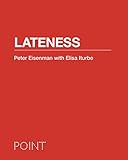Lateness / Peter Eisenman, Elisa Iturbe.
Material type: TextSeries: POINT: Essays on Architecture ; 3Publisher: Princeton, NJ : Princeton University Press, [2020]Copyright date: ©2020Description: 1 online resource (120 p.) : 39 b/w illusContent type:
TextSeries: POINT: Essays on Architecture ; 3Publisher: Princeton, NJ : Princeton University Press, [2020]Copyright date: ©2020Description: 1 online resource (120 p.) : 39 b/w illusContent type: - 9780691147222
- 9780691203911
- Architecture, Modern
- Space and time
- ARCHITECTURE / Criticism
- Dialectic of Enlightenment
- Five Architects
- Frankfurt School
- From Formalism to Weak Form
- Giuseppe Terragni
- Looshaus
- Minima Moralia
- Negative Dialectics
- New York Five
- Ornament and Crime
- San Cataldo Cemetery
- Shadow-Makers
- Spoken into the Void
- Stefano Corbo
- Stephen Kite
- Ten Canonical Buildings
- The Architecture of the City
- architectural history
- architectural theory
- critical theory
- deconstructionist architects
- deconstructionist architecture
- modernist architects
- modernist architecture
- ornamentation
- raumplan
- 724 23
- NA500 .E57 2020
- online - DeGruyter
| Item type | Current library | Call number | URL | Status | Notes | Barcode | |
|---|---|---|---|---|---|---|---|
 eBook
eBook
|
Biblioteca "Angelicum" Pont. Univ. S.Tommaso d'Aquino Nuvola online | online - DeGruyter (Browse shelf(Opens below)) | Online access | Not for loan (Accesso limitato) | Accesso per gli utenti autorizzati / Access for authorized users | (dgr)9780691203911 |
Frontmatter -- Contents -- Series Editor’s Preface -- Introduction -- Lateness: Toward a Definition -- Lateness in the Twentieth Century -- Adolf Loos -- Aldo Rossi -- John Hejduk -- Conclusion -- Acknowledgments -- Notes
restricted access online access with authorization star
http://purl.org/coar/access_right/c_16ec
A provocative case for historical ambiguity in architecture by one of the field's leading theoristsConceptions of modernity in architecture are often expressed in the idea of the zeitgeist, or "spirit of the age," an attitude toward architectural form that is embedded in a belief in progressive time. Lateness explores how architecture can work against these linear currents in startling and compelling ways. In this incisive book, internationally renowned architect Peter Eisenman, with Elisa Iturbe, proposes a different perspective on form and time in architecture, one that circumvents the temporal constraints on style that require it to be "of the times"—lateness. He focuses on three twentieth-century architects who exhibited the qualities of lateness in their designs: Adolf Loos, Aldo Rossi, and John Hejduk. Drawing on the critical theory of Theodor Adorno and his study of Beethoven's final works, Eisenman shows how the architecture of these canonical figures was temporally out of sync with conventions and expectations, and how lateness can serve as a form of release from the restraints of the moment.Bringing together architecture, music, and philosophy, and drawing on illuminating examples from the Renaissance and Baroque periods, Lateness demonstrates how today's architecture can use the concept of lateness to break free of stylistic limitations, expand architecture's critical capacity, and provide a new mode of analysis.
Mode of access: Internet via World Wide Web.
In English.
Description based on online resource; title from PDF title page (publisher's Web site, viewed 27. Jan 2023)


